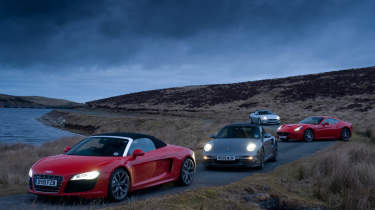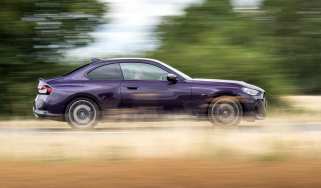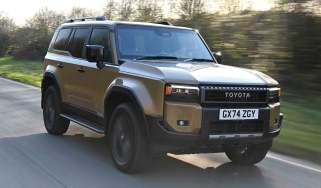Audi R8 Spyder v Porsche 911 Turbo v Jaguar XKR v Ferrari California
The mighty Audi R8 V10 Spyder meets its supercar convertible rivals from Ferrari, Porsche and Jaguar. Full story and 25 hi-res pictures
Only a handful of years ago, the prospect of lining up a £112,500 mid-engined Audi sports car against a Ferrari, a Porsche or even a range-topping Jaguar would have seemed absurd. Yet such is its profit-fuelled ambition and relentless product strategy that Audi is fast becoming the world’s most elastic brand, with model ranges that will ultimately stretch across every niche and sector from city cars to supercars.
With ten cylinders, 518bhp, 390lb ft of torque and an 8700rpm red line, there’s no doubt the R8 Spyder’s 5.2-litre FSI direct injection engine possesses some compelling vital statistics. Coupled to quattro all-wheel drive and, in our test car, a six-speed manual transmission, that’s sufficient to see 0-62mph in a claimed 4.2sec, 0-124mph in 12.7 and a top speed of 194mph. At 1720kg it’s not as light as its aluminium construction might lead you to expect, but before we’ve even turned a wheel it’s clear the £143,320 Ferrari California, £113,467 Porsche 911 Turbo Cabriolet and £78,400 Jaguar XKR Convertible have their work cut out.
I collect the Spyder from Audi’s stunningly futuristic ‘Forum’ in Chiswick, west London. In Brilliant Red with black nappa leather interior, it looks absolutely superb, every bit as good as the coupe. Unfortunately the 250-mile journey to Conwy in north Wales isn’t exactly on my list of great drives, and it’s even worse when you leave the capital at three o’clock on a Friday afternoon. Sure enough it’s a five-hour motorway grind, but the drive is at least useful in proving the Spyder can cope easily with the more mundane end of the motoring spectrum. Its supple ride (thanks to the standard-fit magnetic dampers), smooth clutch, torquey motor and light gearshift make easy work of the often stop-start crawl. Of course, when the opportunity arises, that V10 catapults you down the road, and when you’re just cruising the tremendous Bose hi-fi is more than a match for the combined effects of road, wind and engine noise. The Spyder also gets a ton of attention; proof that a car’s badge needn’t be a barrier to supercar status if all the ingredients are there.
More reviews
Group tests
In-depth reviews
Reviews
- Audi R8 V8 (2007 - 2015) review – the Porsche 911’s equal is a bargain super sports car
- Audi R8 Spyder (2016 - 2024) review – that V10 in surround sound
- Audi R8 V10 RWD and R8 RWD Performance (2020 - 2024) review – Audi's 911 GT3 fighters
- Audi R8 V10 GT RWD (2022 - 2024) review – the R8 bows out in spectacular style
Next morning, while we’re waiting for Roger Green to join us in the California, we head into Denbighshire for a full-on day of driving and photography. I decide to stick with the R8. Partly this is because I feel like I’ve earned it after yesterday’s slog through the traffic, but also because, of the three cars present, the Audi is the most compelling sight.You sit low in the R8, surrounded by the swoops and curves of the high quality interior. The driving position is pretty much perfect, although despite its shallow waistline and decent visibility you do get the impression the Spyder is a broad slice of exotica. The V10 fires with a bang, then settles into a raucous idle until the engine begins to warm and the exhaust bypass valves close. It’s a proper supercar soundtrack; less gritty and shouty than its cousin the Lamborghini Gallardo, but brimming with attitude and potency.
Even in the first few miles you can tell the R8 Spyder shares the Coupe’s beautifully engineered feel and responsive-yet-progressive feel to all the major controls. The manual gearbox is one of the sweetest around, sliding between the alloy fingers of the open gate with rare delicacy and satisfying precision. With the magnetic dampers in their default ‘normal’ setting, the ride is impressively supple at low speeds, and while it’s accompanied by that tautness and sport-biased swagger typical of any high-performance car wearing fat, low-profile rubber, the Spyder is a comfortable car.
Tickle the throttle and the V10 snorts and bellows with proper big-capacity fire and brimstone. A few layers of sharply tailored canvas barely dissipate the noise, so even with the roof up you’re fully aware of the engine’s throttle-controlled mood swings. Drop the roof – a brilliantly theatrical process that’s completed in just 19sec and can be done at speeds up to 31mph – and you’re treated to the full Dolby 7.1 surround-sound experience.
Up on the fast, open section of the fabled ‘evo triangle’ the Spyder is sensational. Raw speed, of course, is a given, but through the cruel mid-corner compressions, tightening radii corners and nasty cambers that define our favourite test route it is brilliantly composed.
It feels a little softer than the V10 Coupe, but to be honest that’s no bad thing. The front end is nicely responsive, but the steering stops short of being hyper-alert, so you can push the car hard into a corner with a solid quarter-turn of lock and lean on the available grip. With practice you can use the tail’s compliance to help keep the front end tucked into the apex, and the Spyder settles into a neutral or slightly tail-led attitude depending on the level of provocation and whether you’ve got the ESP on or off. Though it never feels all-wheel drive, traction is rarely an issue, while the brakes – cast iron (ceramics are a £5K option), drilled and vented, 365mm front and rear – have terrific power and silky progression. After one of the best drives I’ve had in a long time, it’s clear the challenger has thrown down the gauntlet in some style.
With all-wheel drive, 493bhp, a six-speed manual gearbox, claimed 193mph top speed and a power-to-weight ratio of 305bhp per ton, the 911 Turbo Cab is the R8 Spyder’s closest on-paper rival. Yet as I’m about to discover, on the road the contrast in style, hardware and execution couldn’t be more different.
After the occasion and spectacle of the Audi, climbing into the Porsche is a bit of a non-event. Of course it has always been thus with 911s in general, and there’s nothing wrong with the quality, comfort or packaging. It’s just, well, a bit dull and lacking in imagination. Porsche would do well to sprinkle a bit of the Panamera’s interior design magic in the 911’s direction.
Like the R8 Spyder, the Turbo is an easy and approachable car to drive on first acquaintance. Indeed, so long as you don’t stray into the zone where all 493bhp and 479lb ft of torque are unleashed, it’s a spookily docile beast. Switchable dampers (PASM this time) again impart an impressively rounded low-speed ride, while the 911’s tighter dimensions make it easier to thread through tight traffic than the low-slung Spyder. We’d do without this car’s optional ‘sports shifter’, which has succeeded only in making the manual gearshift feel uncomfortably heavy. The roof isn’t quite as mesmerising to watch as the R8’s as it folds itself into the tail, but it’s quick and neat and doesn’t seem to make the car look quite so hunchbacked as before, although this could be due to the fixed rear wing on the engine cover.
Despite its lack of cylinders there’s real character to the Turbo’s engine, even though Porsche has softened, smoothed and massaged the power delivery of this new direct-injection motor. You get a real sense of it filling its lungs and then there’s this terrific, dragon-like roar as it exhales, which is quite different to any other 911 in character and delivery. Because the car feels small and wieldy you tend to drive it in a more attacking manner, to the point where you use it almost like a gun, aiming it into the corner then using the monster torque and stumpy gearing to fire it down the straight.
In my mind the 911 Turbo has always been the supreme Jekyll and Hyde character: happy to mooch or do the motorway thing, yet uniquely visceral and hot-headed when roused. This Gen 2 car does the humdrum stuff as well as ever, and it’s also ridiculously rapid, but the boost zone is now broader and more linear, so that addictive whizz-bang explosiveness has morphed into a sustained and ever more insistent s-q-u-e-e-z-e of acceleration. There’s no denying it’s quicker than ever as a result, but there’s now a degree of remoteness and isolation from the process of making the Turbo go quickly. The numb and slightly glassy steering doesn’t help either, for it separates you further from the action, as if to suggest the Turbo simply requires you to sit still and shut up. There remains something undeniably awesome about this surreal, almost disdainful delivery, but it’s impossible not to conclude that after the R8 Spyder the Turbo Cabriolet feels like a supremely quick fairground ride.
Swapping into the Jaguar is a huge culture shock. The XKR is a big car, and at 1800kg pretty chunky too, yet from the moment you press the starter and the supercharged V8 crackles crisply into life it exudes a far more sporting character than your preconceptions about Jaguars may have prepared you for. Initially the light steering, silky ride and torque converter auto ’box build a picture of calm, assured but ultimately soft-focus performance, yet with familiarity comes speed, and with speed comes a growing sense that the XKR is something of a concealed weapon. The 5-litre supercharged V8 is a mighty engine with 503bhp and 461lb ft of torque, and while it doesn’t rev like the Spyder, it is smooth, responsive, expressively vocal and tremendously muscular. So far as this graceful convertible is concerned, looks can indeed be deceiving.
The auto ’box has an intuitive sense of what gear you want, not to mention a satisfying ability to execute rev-perfect throttle-blip downshifts, so the XKR is a keen and responsive partner. Using the steering wheel paddles brings another level of control, and when used in conjunction with Sport and Dynamic modes the Jag really comes alive.
Up on the challenging moorland section of the test route, the XKR’s poise pays dividends, soaking up the punishment without being deflected from its trajectory, and carrying great speed without ever feeling ragged. What’s really impressive is its ability to maintain its composure, yet also display tight body control and sweet progression.
With such power and torque and only the rear wheels to transmit it to the tarmac, traction can be at a premium in the Jag if you get back on the gas early. But far from feeling untidy, or spinning an inside wheel, the XKR (complete with electronic ‘diff’) shifts seamlessly into the most natural oversteer. Not a big-armfuls-of-lock showboating powerslide, but a poised, balanced and exploitable stance that needs subtle correction and feels brilliant.
The brakes, though unimpressive when viewed through the spokes of the 20in rims, work extremely well. There’s slightly more initial pedal travel than in the Audi or Porsche, but for road use the feel and progression are first rate. So while it’s true the Jag can’t quite match the Germans for outright pace, and it doesn’t have the iron control and incisive responses of the Spyder in particular, for sheer fun and dynamic expression the XKR is an absolute blast.
The last piece of this puzzle is the California. A softcore sports car that moves Ferrari into previously uncharted territory, it is a real departure for the Maranello brand, and consequently very hard to pigeonhole.
With a high-revving, 453bhp, 358lb ft, naturally aspirated V8, it is the least potent car here. At 1735kg it is lighter only than the XKR, yet thanks to Ferrari’s new twin-clutch paddle-shift transmission it is a match for the 911 Turbo from a standstill to 60mph (3.8sec in case you were curious), and comes within an ace of matching both the Spyder’s and the Turbo’s vmax of 194mph. That’s mighty impressive.
The California’s exterior is bulky and rather awkwardly proportioned, but the interior is a real event. Pale cream might not be the most practical colour, but there’s no denying that the soft leather, strikingly designed instruments and adventurous cockpit architecture make it a special place to sit.
Press the red button on the steering wheel and the V8 starts with a flat-plane blare much like that of a 430 or 458, while a stab of the throttle reveals razor response. The steering is light and quick-witted, as is the modern tradition at Maranello, and this is matched to an equally keen front end. An array of rim-mounted shift-lights completes the picture. So far, so sporty…
At low speeds the California delivers on Ferrari’s promise of a supple, less demanding open-air GT, and on gently curving sections of the A5 it flows with an easy, relaxed style. There’s not a huge amount of feedback or connection through the steering wheel, but you simply learn to trust in the grip from the P Zeros and soon settle into the Cali’s refreshing take on Ferrari motoring.
There’s a surprising amount of body roll though, and as our speed increases there’s a growing sense that the rear end in particular is under-damped. It squats under the effort of keeping pace with the front end and the weight falls onto the outside rear wheel, as you can clearly see in the cornering shot on page 71. There’s so much grip at the front that understeer is never an issue, which would be great if only the rear was in harmony. Instead what you get is a car that’s oddly disunited front to rear. The result is a curious sensation of turning in, then almost immediately counter- steering to settle the tail. Ferrari will doubtless shudder at the comparison, but it reminds me of an early TVR Tuscan, which also had super-responsive steering, zero understeer and an under-damped tail.
This lack of body control manifests itself in other ways, most obviously through compressions, when assorted bits of underfloor aerodynamic addenda noisily grind themselves into plasticky swarf on the coarse Welsh tarmac. That none of the other cars skimmed the road shows the softness of the Cali’s chassis set-up.
It’s an unfathomable situation given that Italy, and Modena in particular, is home to some of Europe’s gnarlier and more challenging roads. It’s also hugely frustrating, for the vocal, rev-hungry, front-mid-mounted V8, super-snappy transmission and carbon brakes are a compelling and memorable combination.
When the roads suit it, the California’s potential is abundantly clear, but I simply can’t believe that you buy a Ferrari – even a softcore Ferrari such as the California – just to use it on ordinary roads. Yet when you inevitably stray from its comfort zone and drive it quickly, it feels all at sea.
That the California finishes last in this test is as disappointing as it will doubtless be controversial. Ferraris are built to be adored, and in my experience are almost impossible to resist. But after 500 miles in the company of the Audi, Jaguar and Porsche, on roads topped by the wide open space of Denbighshire and tailed with the city streets of Liverpool, it’s clear that this particular Ferrari can finish no higher.
The 911 Turbo is next to fall. Despite being awesomely fast, crushingly capable and everyday-useable, there’s something remote and detached about the driving experience. Given Porsche’s ability to build 911 models of spectacular ‘rightness’, the Turbo’s lack of connection is proof that, Motorsport models aside, even Porsche can sometimes miss the mark when it comes to the black art of tactility.
There’s no question the Jaguar has been the big surprise of this test. That nothing here comes close to the smooth, soothing way the XKR makes progress is far from unexpected, but it’s when the road opens out and the pace increases that the Jaguar is a revelation, delivering freely given pace and natural, fluid poise of a kind that exposes the failings of both the California and Turbo. It’s a peach.
But despite the Jag’s strong showing, the R8 Spyder is a convincing winner. There aren’t any quirks or traits to forgive, no dynamic flaws to gloss over. Everything about it feels spot-on and it looks and sounds sensational. Right now it’s the best open-air sports car money can buy.
We’re indebted to Signature Car Hire for supplying the California at extremely short notice. Thanks guys. If you’d like to find out how you can hire the Ferrari, or any of the other supercars on Signature’s books, including various Lambos and Porsches, call 0845 370 2222 or visit www.SignatureCarHire.co.uk



